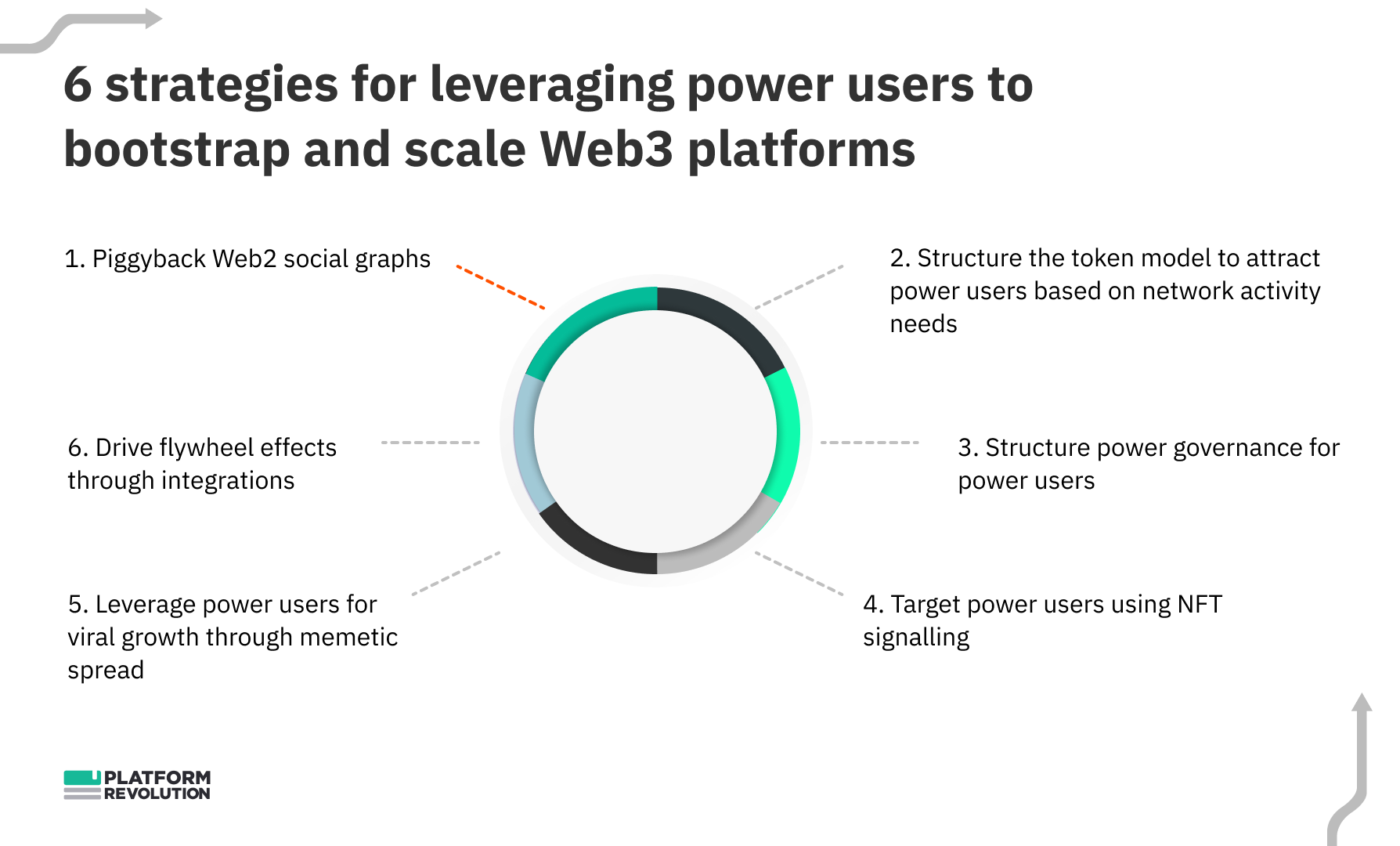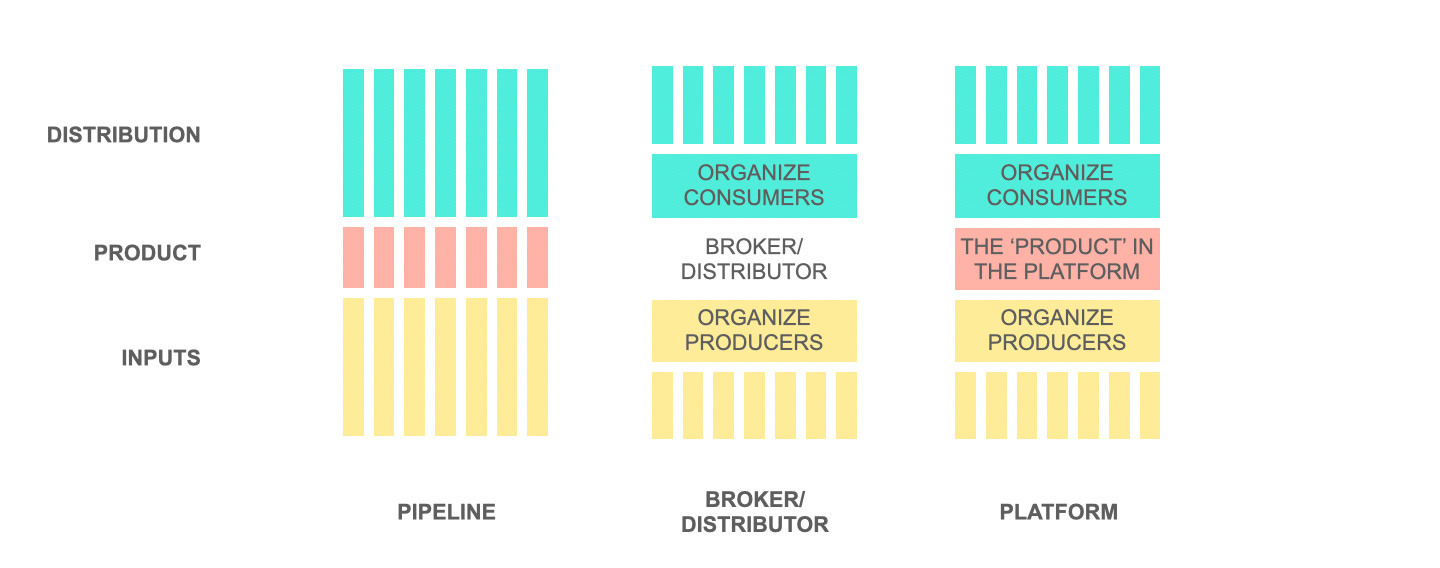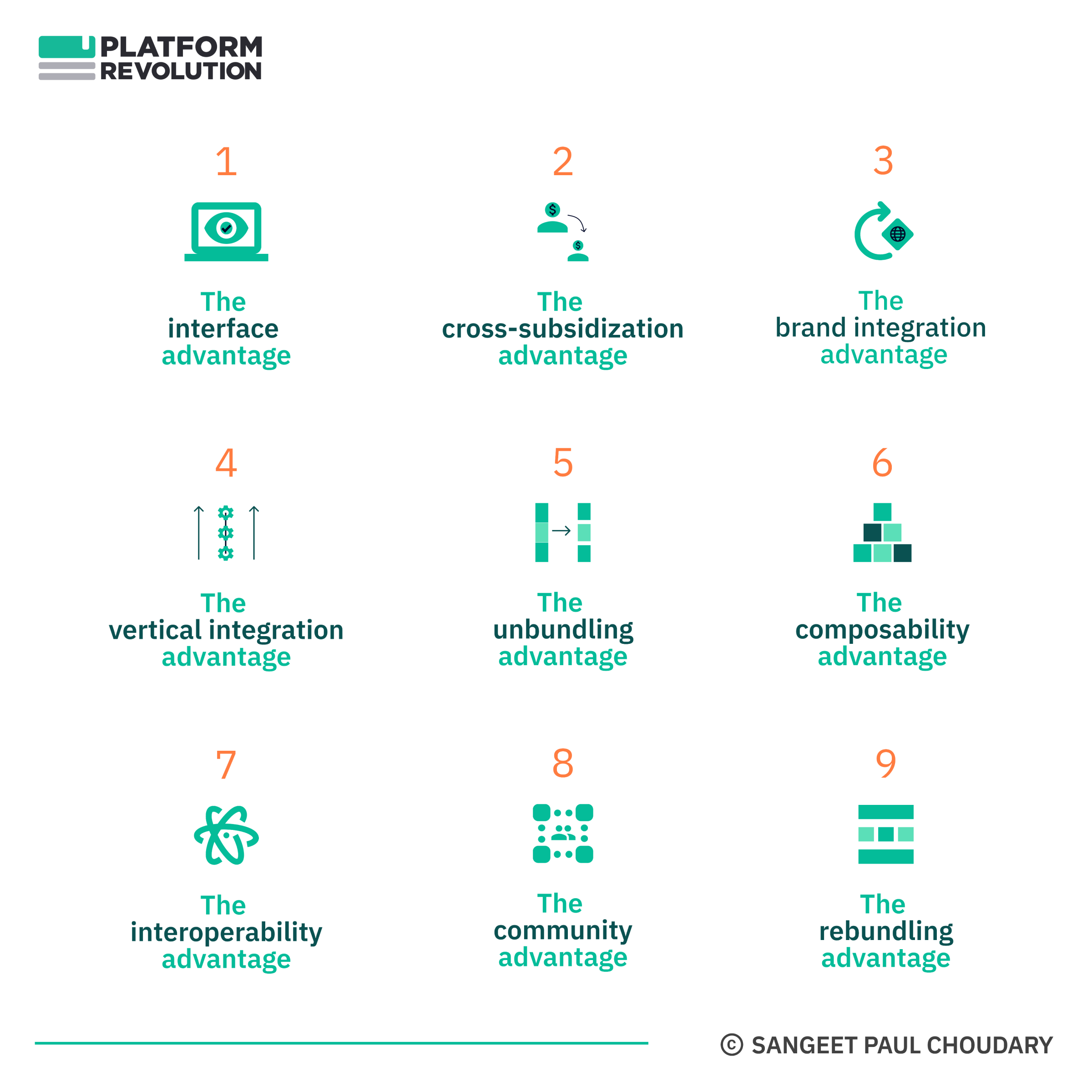Strategy
Web3 Network Effects: Leveraging Power Users
Web2 platforms like Kickstarter, Udemy, and Skillshare scaled by getting power producers onto the platform early on. These producers, in turn, onboarded their followers as consumers, some of whom, then further converted into producers and a cycle of user acquisition and ever-increasing network effects started building up.
Owing to tokenised ownership, Web3 platforms can turbocharge power user strategies. As centralized ownership of the platform decreases, power users play an increasingly important role by driving growth of the platform and reaping the ensuing gains.
This essay provides a teardown in one of the most important Web3 strategies: Leveraging power users.
Specifically, this essay explores 6 strategies for leveraging power users to bootstrap and scale Web3 platforms.
- Piggyback Web2 social graphs
- Structure the token model to attract power users based on network activity needs
- Structure power governance for power users
- Target power users using NFT signalling
- Leverage power users for viral growth through memetic spread
- Drive flywheel effects through integrations
This article is part of the upcoming Web3 Bootstrapping Playbook. Sign up here to get early access to the playbook when it launches:
GET YOUR COPY TODAY
Why power users matter
Power users play a key role in the creation of network effects. Not all nodes on a network are equal, some – power users – contribute much higher activity to the network than others.
Power users may be power producers or power consumers or both. Power producers bring higher supply to the platform. Power consumers are responsible for driving demand. Power users drive outsized activity on the platform. Early on, getting power users onto the platform helps overcome the chicken and egg problem that most platforms face.
Web2: Power users gain transactionally only
On Web2 platforms, power users primarily derive transactional benefits. For instance, a project creator on Kickstarter would promote their project to their social media following and mailing lists to benefit from crowdfunding. Online education marketplaces like Skillshare started by onboarding star educators like Seth Godin who would then promote their course to an established following they had already built outside the platform.
In both these examples, the transactional benefits of the platform (get your project funded on Kickstarter, sell your course on Skillshare) were the primary reasons why producers brought their following onboard the platform. In some cases (e.g. Skillshare), the platform didn’t charge transaction fees on transactions where the producer had onboarded off-platform followers. However, benefits for power producers on Web2 platforms were limited to such transactional benefits.
Web3: Turbocharging power user engagement
Web3 platforms unlock three additional value levers for power users (particularly producers) to benefit from bringing their following on board. Through fungible and non-fungible tokens, power producers gain greater returns on their actions in helping grow an underlying platform.
-
- Tokenized platform ownership benefits: First, Web3 platforms can award tokens to power users which enable them to gain ownership benefits beyond the transactional benefits that Web2 platforms provided. For instance, a power user on a Web3 platform may benefit from more platform transactions by bringing followers on board, and also from earning more tokens as reward for actions like onboarding their following. As the underlying protocol usage scales, the growing token value accrues upside in the favour of these power users. In this manner, the power user gains the benefits of both transactional volume on their own creations as well as growth in underlying protocol usage.
- Tokenized content ownership benefits: Second, Web3 platforms also provide content ownership benefits when products or content created by power users are set up as non-fungible tokens (NFTs). While Web2 platforms only allowed creators to gain transactional benefits from the first transaction, Web3 platforms can enable power users to gain ownership benefits beyond the first transaction as they continue to see benefits from secondary transactions conducted by subsequent owners of the product/content.
- Fractional ownership benefits: NFTs may also be fractionalized and reused by other platform users. For instance, course creators on Udemy and Skillshare only benefited from the transaction of the actual course. A Web3 online learning platform could allow creators to set up courses as NFTs. Components of these courses could be fractionalized and used by other course creators within their own courses, while the underlying NFT would allow superior copyright ownership and attribution, ensuring that proceeds from the sales of derivative courses also accrue to the original course creator.
Effectively, through additional ownership benefits – both in terms of platform ownership and content ownership – power users are incentivised to keep promoting not just their own content (as they already did in Web2) but also the underlying platform and any derivative content that is created on the platform.
A web3 platform would provide transactional benefits on the listing as well as ownership benefits in the platform, making it more attractive to be an early power producer on a Web3 accommodation platform.
Feel Free to Share
Download
Our Insights Pack!
- Get more insights into how companies apply platform strategies
- Get early access to implementation criteria
- Get the latest on macro trends and practical frameworks
Ownership benefits drive growth of power users
A lot of Web3 enthusiasts claim that ownership benefits will change platform economics by allowing consumers to monetize their data to their own advantage. While that may well be one of the possibilities unlocked by ownership, I believe that the benefits of ownership will first accrue to power users who already look to platforms to monetize their value and will embrace Web3 for the many new ways that value unlocks in their favor. Ownership enables power users to better capture the value they bring in terms of influence, community attention, meme spread, and thought leadership.
Ownership benefits can fundamentally grow the market of power users. Consider, for example, the number of new businesses that mushroomed on Airbnb, for the transactional benefits of leasing a house. A web3 platform would provide transactional benefits on the listing as well as ownership benefits in the platform, making it more attractive to be an early power producer on a Web3 accommodation platform. Ownership benefits transform passive interest into active contribution and could unlock a much larger market of power producers.
Strategies to engage power users
1. Piggyback Web2 social graphs
For all the vilification of Web2 by Web3 enthusiasts, Web3 evangelism and adoption has ironically largely piggybacked Web2 social graphs. Many Web3 projects gain adoption through Twitter influencers tweeting about them.
Power users play an important role as they bring the power of their Web2 social graphs to onboard users to Web3. Web2 social graphs will likely play a very important role in driving Web3 adoption, much like a lot of initial onboarding to Web2 platforms piggybacked the email networks that users had.
Twitter, in particular, seems poised to play a significant role in bridging Web2 with Web3.
Power users on Twitter are well positioned to leverage their clout to kickstart Web3 networks. Twitter, for its own part, has been one of the few Web2 platforms looking to actively embrace Web3. Its cryptocurrency tipping service allows Twitter users to add their Bitcoin address and receive tips. Users can also connect a cryptocurrency wallet, import their OpenSea NFT collection, and choose an avatar to display as a verified NFT on their profile picture.
2. Structure the token model to attract power users based on network activity needs
Early users on Web2 platforms would gain outsized influence on the platform. Web3 platforms can similarly attract power users on board early by offering outsized ownership benefits.
These higher incentives may accrue in two ways.
First, power users who come on board early receive tokens at a lower price. The more the network grows over the coming days, the greater their upside.
Second, early power users may also be given more tokens for the same action, compared to users who join later.
To implement this, token rewards to users may be modeled as a function of the network size and/or transaction frequency. A decrease in network activity would result in increased token rewards to attract power users. As activity goes back up, the rewards would recalibrate. In this model, lowering network activity would reduce token price and increase token rewards. This doubly rewards power users who come on board when the network needs them most, and helps grow network activity
3. Structure power governance for power users
In addition to ownership benefits, Web3 platforms may also attract power users by giving them greater governance rights. This can be directly tied to the ownership advantage by tying governance votes to token ownership.
For instance, Braintrust, the Web3 services marketplace has a one token one vote system. Any structural changes require a community vote. Power users have greater voting power, which ensures that they stay engaged not just in driving network activity but in evolving the platform roadmap and driving key strategic decisions.
To engage power users further through governance, a Web3 platform could create a power user DAO, where power users discuss new innovation ideas, shape platform roadmap, and also act as a ‘community advisory board’ to provide insights on features the community needs. While Web2 platforms also set up customer advisory and oversight boards, Web3 platforms can use tokens to scale this through a DAO.
4. Target power users using NFT signalling
A significant number of Web3 power users hold rare NFTs. NFT ownership serves as a not-so-subtle signaling mechanism in Web3 communities. But this can also serve as a targeting mechanism for new projects looking to target certain types of power users. Users who own a particular type of NFT signal a specific skill-set and can attract access associated with that skill-set.
Web3 projects may actively target NFT holders through free airdrops to holders of specific NFTs. Alternatively, they may passively target NFT holders by allowing NFT-based access to key roles on the platform. For instance, the Degen Score serves as a reputation signaling mechanism in Web3 to gain access to Web3 projects as a developer.
A word of caution while using NFTs as a reputation signaling mechanism. The tradable nature of NFTs (as opposed to, say, a five-star rating on Fiverr) makes it easy to game the system or buy your way into it without putting in the hard work. This, may, expose a project to low quality users and developers if it uses NFT ownership as the sole reputation signalling mechanism.
5. Leverage power users for memetic spread
Memes play an important role in mobilising communities towards a project and in driving early adoption. Power users, combined with their ability to mobilize their social graphs, again play an important role.
To leverage power user advocacy, Web3 projects may also look at creative ways to drive viral growth through power users spreading memes. For instance, the launch of Crypto Covens triggered a meme where users would display their “web3 self” alongside their “web2 self”.
This virality is further encouraged, for example, by Web2 platforms like Twitter enabling the social display of NFT profile pictures. An OpenSea API-linked hexagonal-shaped profile picture allows Twitter users to prove ownership of their NFTs.
6. Drive flywheel effects through integrations
Integrations with other platforms are a significant driver of network effects in Web3.
Platforms with a greater number of integrations will more successfully attract power users. The more activity generated through integrations, the greater the value to power users. This also has a feedback effect as more power users drive greater activity on the native platform, making it more attractive for other platforms to integrate with it.
For instance, a Web3 commerce platform can increase distribution by partnering with other platforms to show specific selections of inventory. OpenSea’s White Label program is one such example. Boson Protocol also leverages integrations to scale network effects.
Ownership benefits further accrue to creators as purchases funneled through a third party integration provide a share of the sale to the affiliate/integration and a share to the original producers/creators, who earn a percentage of any secondary sales. Essentially, the opportunity to benefit from secondary sales is amplified through such integrations. Power users, who wouldn’t have seen kickbacks from secondary sales in Web2, are further encouraged to promote Web3 platforms which account for higher sales of their items, which again is accelerated through such integrations.
The Web3 Playbook
Sign up here to get early access to the playbook when it launches:
Get the Web3 Builders Playbook
State of the Platform Revolution
The State of the Platform Revolution report covers the key themes in the platform economy in the aftermath of the Covid-19 pandemic.
This annual report, based on Sangeet’s international best-selling book Platform Revolution, highlights the key themes shaping the future of value creation and power structures in the platform economy.
Themes covered in this report have been presented at multiple Fortune 500 board meetings, C-level conclaves, international summits, and policy roundtables.
Subscribe to Our Newsletter














